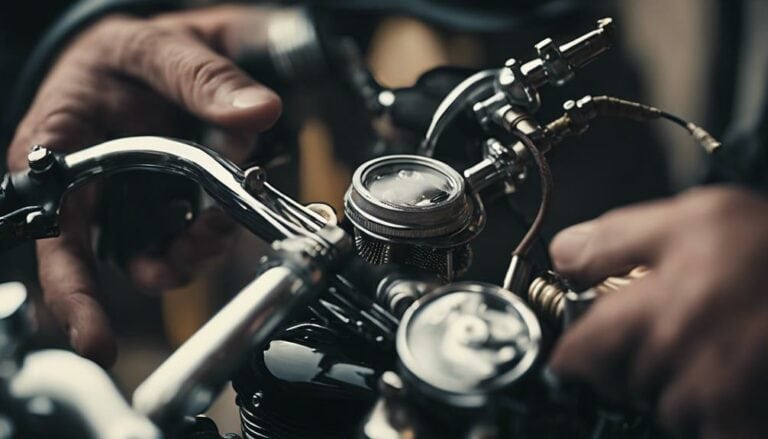When it comes to setting the idle on your Harley Davidson, precision is key. Have you ever wondered about the nuanced adjustments that can make a significant difference in your bike's performance?
Understanding how to fine-tune the idle can enhance not just the sound but the overall operation of your Harley. By following the proper steps and taking the time to get it just right, you can ensure a smoother ride and optimize your Harley's performance.
Let's explore the essential steps to master this fundamental aspect of Harley maintenance.
Key Takeaways
- Proper idle adjustment with the idle screw ensures smooth engine operation.
- Using a 12-inch Philips screwdriver aids in precise idle adjustment.
- Checking for vacuum leaks and spark plug health is crucial for consistent idle.
- Smooth idle prevents issues like backfiring and optimizes performance.
Understanding the Idle on Your Harley
To properly adjust the idle on your Harley Davidson, you must first understand the basic mechanics of the idle system in your V-twin motorcycle equipped with CV carburetors. The idle adjustment screw on your Harley is a vital component that controls the amount of air and fuel mixture allowed into the engine while it's idling. It's essential to make sure that this mixture is precise for optimal engine performance.
When the idle is set correctly, it prevents the engine from running too rich or too lean, ensuring a smooth and efficient operation. Incorrect idle adjustment can result in issues such as high or low idle, backfiring, and overall poor bike performance. By grasping the importance of idle adjustment, you can maintain engine longevity, improve fuel efficiency, and maximize your Harley's overall performance on the road.
Understanding the idle system in your Harley is the first step towards achieving a perfectly tuned motorcycle that runs smoothly and powerfully.
Locating the Idle Adjustment Screw
Located on the left side of the carburetor, you'll find the idle adjustment screw on your Harley Davidson. Understanding its location and function is crucial for carburetor maintenance and troubleshooting tips. Here are some key points to consider:
- The idle adjustment screw is a small screw with a slot for a screwdriver that controls the amount of air flowing into the carburetor at idle.
- This screw plays a significant role in setting the engine's idle speed, which directly impacts throttle response.
- Proper adjustment of the idle screw can prevent stalling, rough idling, and other performance issues in your Harley Davidson.
- Locating the idle adjustment screw is fundamental for engine tuning and ensuring optimal performance upgrades.
- By familiarizing yourself with the idle adjustment screw's position and function, you'll be better equipped to maintain smooth operation and address any idle-related concerns effectively.
Adjusting the Idle Speed Properly
Adjusting the idle speed properly on your Harley Davidson V-twin motorcycle with a CV carburetor requires a 12-inch Philips head screwdriver and attention to detail to optimize engine performance and prevent potential issues with fuel efficiency and backfiring.
Before starting, ensure the motorcycle is in neutral to avoid any accidents. To adjust the idle speed, locate the idle adjustment screw on your carburetor. Turning the screw clockwise increases the idle speed, while turning it counterclockwise decreases it.
Aim for a smooth and steady idle that prevents the engine from running too rich, which can impact fuel efficiency and overall performance. The optimal idle speed helps prevent backfiring and ensures a consistent engine operation.
If you encounter any issues during the adjustment process, consider these idle troubleshooting tips: check for air leaks, inspect the throttle cables, and ensure the carburetor is clean.
Following these idle adjustment techniques and recommendations will help maintain your Harley Davidson in top condition.
Testing and Fine-Tuning the Idle
When fine-tuning the idle on your Harley Davidson motorcycle, utilize a tachometer to adjust the idle speed according to the manufacturer's specifications. Here are some steps to help you in testing and fine-tuning the idle:
- Idle troubleshooting techniques: Use diagnostic tools to identify any underlying issues affecting the idle performance.
- Idle performance evaluation: Listen attentively to the engine sound and feel for any vibrations to evaluate the smoothness of the idle.
- Idle adjustment challenges: Make small adjustments to the idle mixture screw and monitor the impact on the idle speed.
- Check for vacuum leaks: Inspect the system for any leaks that could affect the idle quality during fine-tuning.
- Repeat adjustments: Keep refining the idle speed in small increments until it stays steady, smooth, and falls within the recommended range.
Maintaining a Consistent Idle
To maintain a consistent idle on your Harley Davidson motorcycle, ensure that the idle speed is adjusted precisely using a 12-inch Philips head screwdriver for optimal tuning. Proper idle adjustment is essential for preventing issues like backfiring and ensuring a smooth ride. Here are some idle consistency tips to help you troubleshoot idle issues and master idle adjustment techniques:
| Idle Consistency Tips | Troubleshooting Idle Issues | Idle Adjustment Techniques |
|---|---|---|
| Check for vacuum leaks | Ensure spark plug health | Use screwdriver to adjust |
| Clean throttle body | Verify air filter condition | Adjust idle when warm |
| Inspect fuel system | Adjust idle mixture screws | Check for smooth idle |
Conclusion
Congratulations! You have successfully set the idle on your Harley Davidson, ensuring optimal performance and engine longevity. Remember, maintaining a consistent idle is crucial for a smooth ride.
But hey, if you enjoy the thrill of high or low idle symptoms and the occasional backfire, who am I to stop you? Just kidding, stick to the proper idle adjustment for a safe and enjoyable ride every time.

